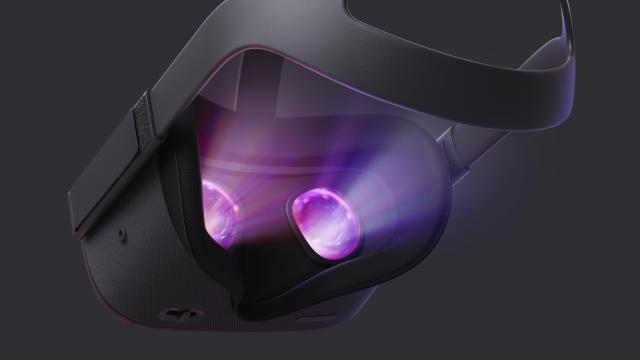“This is it,” Mark Zuckerberg said to a crowd of developers and press at Facebook’s annual VR developers conference, Oculus Connect. “This is the all-in-one VR experience that we have been waiting for. It’s wireless, its got hand presence, six degrees of freedom, and it runs Rift-quality experiences.”
Zuckerberg was at Oculus Connect to announce a new standalone VR headset called Oculus Quest. This isn’t the first standalone headset in the market, or even from Facebook, but unlike the wimpy $299 Go that launched earlier this year, the Quest promises to be a powerful machine capable of the kind of incredible graphics usually only found in VR headsets powered by beefy external PCs.
That’s exciting, because standalone headsets, such as the Go and Google and Lenovo’s Daydream, have been pretty sad affairs. Sure they give you VR, and you can watch movies and maybe play some games, but the graphics are practically N64 quality and you’re constantly mindful of the fact that you have little more than a fancy phone strapped a few centimetres from your eyeballs.
The Quest would be different because, according to Oculus, the headset will be much more capable, while pumping content out at a higher-than-typical resolution of 1600 x 1440 per eye (the Daydream and Go headset both have a resolution of 1280 x 1440 per eye).
The problem is that Oculus made no mention of what exactly is powering this tiny beast. That’s kind of a big concern, because virtual reality programs are very resource intensive. You need a good CPU, and if you want Rift level content you really need a powerful GPU — such as AMD’s Radeon RX 56 — which goes for nearly $700, or you need to suck it up and go with crummier graphics while saving money on something like Nvidia’s GeForce GTX 970 — which can be had for around $350 if you’re lucky.
Even PC makers have struggled to make “VR ready” PCs at a low price point — $450 to $550 is the price you often see for these machines, but they’re desktops. They’re big. Cramming all of that into something that sits comfortably on your face is impressive on Oculus’s part.
As is the fact that it would ostensibly not need to be cooled as much as those above GPUs — which get awfully warm when rendering VR environments.
So how exactly is Oculus producing a VR headset that stays cooler and weighs less than a similarly powerful desktop computer, all while costing just $US400 ($551) and running “Rift-quality experiences”?
As for what is powering the damn thing, Oculus told Gizmodo the Quest will have a Qualcomm Snapdragon 835 processor. That’s more powerful than the 821 found in the Go and the same processor found in Lenovo and Google’s Daydream headset, as well as smartphones such as the Samsung S8. Traditionally it is not as capable of 3D rendering as the CPUs and GPUs found in the PCs that power the Oculus Rift. However, we haven’t yet had the opportunity to try out the Oculus Quest so we’ll reserve judgement.
